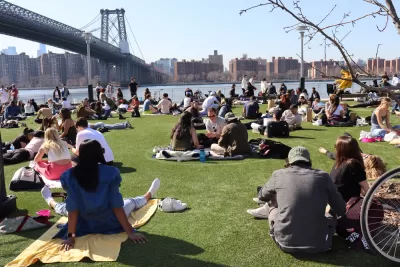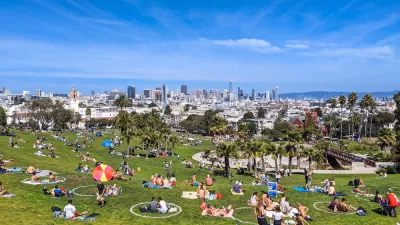The pandemic forced a large-scale reexamination of how public spaces and urban form impact public health and equity. Now, policymakers can learn from those innovations to plan for the future of cities.

A "recent Knight Foundation study, led by international design group Gehl, looked at seven public spaces in four cities during the pandemic, in order to determine what made them thrive." As James Finley writes in Next City, "In addition to unique tactics deployed by local teams, the study found that a key ingredient of successful public spaces was putting community members at the center of the work, which enabled spaces to be developed and activated in a way that met diverse resident needs."
The study highlighted the urgency of designing impactful infrastructure projects as unprecedented levels of federal funding is distributed to cities as part of the American Rescue Plan and the Infrastructure Investments and Jobs Act. "This once-in-a-lifetime influx of resources can be used to promote the reinvigoration of inclusive and safe outdoor spaces that will increase exposure to the arts, prepare for future generational shifts, and prioritize equity to engage marginalized populations."
"Among parks surveyed in the Knight study, several experienced an increase in foot traffic. In particular, the Detroit Riverfront and Philadelphia’s Cherry Street Pier both saw a threefold increase in use from November 2019 to November 2020. This suggests that community-led design creates a meaningful opportunity for planners to respond to an increased desire for public space moving forward," writes Finley. The study concludes that "our revitalized public spaces must be adaptable to how people want to use them from moment to moment, and year to year."
The study recommends "conscious placement and design" of underused urban spaces that can be reinvigorated as multifunctional parks with "broadly applicable features" that are useful and relevant to a broad segment of users. The study's authors encourage robust public engagement to understand the diverse needs and desires of diverse communities. "[C]ity planners need to fully embrace community-led design and follow the individual preferences and listen to the needs of their unique populations."
FULL STORY: Living With the Virus Means Designing Innovative Public Spaces of the Future

Maui's Vacation Rental Debate Turns Ugly
Verbal attacks, misinformation campaigns and fistfights plague a high-stakes debate to convert thousands of vacation rentals into long-term housing.

Planetizen Federal Action Tracker
A weekly monitor of how Trump’s orders and actions are impacting planners and planning in America.

In Urban Planning, AI Prompting Could be the New Design Thinking
Creativity has long been key to great urban design. What if we see AI as our new creative partner?

King County Supportive Housing Program Offers Hope for Unhoused Residents
The county is taking a ‘Housing First’ approach that prioritizes getting people into housing, then offering wraparound supportive services.

Researchers Use AI to Get Clearer Picture of US Housing
Analysts are using artificial intelligence to supercharge their research by allowing them to comb through data faster. Though these AI tools can be error prone, they save time and housing researchers are optimistic about the future.

Making Shared Micromobility More Inclusive
Cities and shared mobility system operators can do more to include people with disabilities in planning and operations, per a new report.
Urban Design for Planners 1: Software Tools
This six-course series explores essential urban design concepts using open source software and equips planners with the tools they need to participate fully in the urban design process.
Planning for Universal Design
Learn the tools for implementing Universal Design in planning regulations.
planning NEXT
Appalachian Highlands Housing Partners
Gallatin County Department of Planning & Community Development
Mpact (founded as Rail~Volution)
City of Camden Redevelopment Agency
City of Astoria
City of Portland
City of Laramie





























